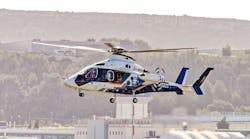CINCINNATI, Ohio, 25 Sept. 2014. "As the role of the engine evolves, we have to understand the systems around it and support subsystems," says Michael L. Zierolf, vehicle energy systems design & integration systems engineer at GE Aviation in Cincinnati, Ohio. Zierolf and his colleagues at GE Aviation presented at SAE's Aerospace Systems and Technology Conference (ASTC) in Cincinnati, Ohio, this week.
An aircraft is increasingly regarded as "a system of systems," requiring a more holistic, integrated approach to systems design engineering, test, and integration.
The elements of an integrated modeling approach to the aircraft engine and interfaces include:
- engine,
- fuel thermal management system (FTMS),
- adaptive power and thermal management system (APTMS)
- generators,
- power distribution units, and
- power storage devices.
"All these components build up this integrated system model," Zierolf explains. "The heat exchangers are the glue, the bridge, the link between subsystems."
Traditional software development processes can be applied to model development. It starts with requirements, decomposed into architecture and interface design as well as detail design; then, that gets coded into an executable and is submitted to unit test, integration, and system test.
"I view models in themselves as requirements," Zierolf says. "I can hand off a model and say 'you need to design to this model as a requirement or specification.' The real value of this is communication – writing it down not for requirements tracking but for communications, to understand what everyone is doing. A version description document shows what all the versions are and, more importantly what models are compatible (e.g., compatibility table)."
Engine performance metrics are expanding to include mission-level power generation and thermal requirements, Zierolf summarizes. "Constructing models that integrate the engine with ancillary subsystems provides valuable insight into system-level behavior and engine performance impacts. We cannot work with our heads down; we need to be aware of what is happening around us," Zierolf recommends. Additionally, he mentions, the software development process to modeling effort provides valuable guidance to creating integrated models.




